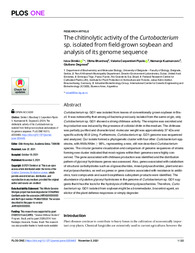The chitinolytic activity of the Curtobacterium sp. isolated from field-grown soybean and analysis of its genome sequence.
The chitinolytic activity of the Curtobacterium sp. isolated from field-grown soybean and analysis of its genome sequence.
Author(s): DIMKI?, I.; BHARDWAJ, V.; CARPENTIERI-PIPOLO, V.; KUZMANOVI?, N.; DEGRASSI, G.
Summary: Curtobacterium sp. GD1 was isolated from leaves of conventionally grown soybean in Brazil. It was noteworthy that among all bacteria previously isolated from the same origin, only Curtobacterium sp. GD1 showed a strong chitinase activity. The enzyme was secreted and its production was induced by the presence of colloidal chitin in the medium. The chitinase was partially purified and characterized: molecular weight was approximately 37 kDa and specific activity 90.8 U/mg. Furthermore, Curtobacterium sp. GD1 genome was sequenced and analyzed. Our isolate formed a phylogenetic cluster with four other Curtobacterium spp. strains, with ANIb/ANIm � 98%, representing a new, still non described Curtobacterium species. The circular genome visualization and comparison of genome sequences of strains forming new cluster indicated that most regions within their genomes were highly conserved. The gene associated with chitinase production was identified and the distribution pattern of glycosyl hydrolases genes was assessed. Also, genes associated with catabolism of structural carbohydrates such as oligosaccharides, mixed polysaccharides, plant and animal polysaccharides, as well as genes or gene clusters associated with resistance to antibiotics, toxic compounds and auxin biosynthesis subsystem products were identified. The abundance of putative glycosyl hydrolases in the genome of Curtobacterium sp. GD1 suggests that it has the tools for the hydrolysis of different polysaccharides. Therefore, Curtobacterium sp. GD1 isolated from soybean might be a bioremediator, biocontrol agent, an elicitor of the plant defense responses or simply degrader.
Publication year: 2021
Types of publication: Journal article
Unit: Embrapa Wheat
Keywords: Curtobacterium sp, Enzyme, GD1, Soybeans
Observation
Some of Embrapa's publications are published as ePub files. To read them, use or download one of the following free software options to your computer or mobile device. Android: Google Play Books; IOS: iBooks; Windows and Linux: Calibre.
Access other publications
Access the Agricultural Research Database (BDPA) to consult Embrapa's full library collection and records.
Visit Embrapa Bookstore to purchase books and other publications sold by Embrapa.

